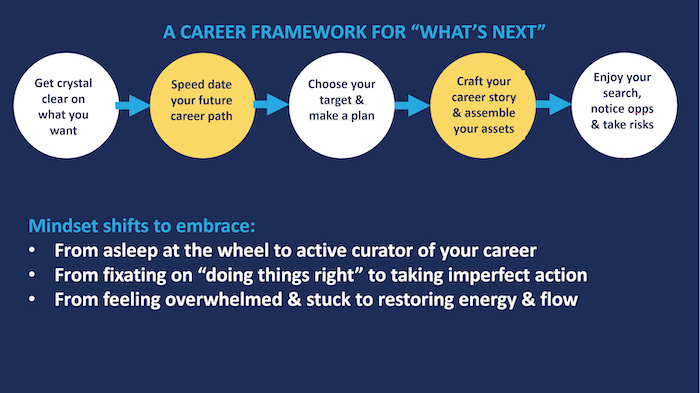Almost daily I am asked how to think about and approach a possible, proactive job or career transition. The questions come in various forms, such as:
- How do I know when it’s time to leave my job?
- How do I think about what is important, to get to the next place?
- What should the path to what’s next look like?
- How do I figure out what is next for me?
- How do I figure out what is possible for me?
- What’s next for me when I use purpose as the lens?
If you need a framework to help you navigate similar questions, here is the one I use with our executive clients, that has worked for professionals of all stripes, in thousands of different permutations.
The framework is based on the premise that first you must turn your focus inward before considering options and engaging with the job market to find what feels practical and feasible. You must reflect on what is important to you about the next phase of your career to recognize it when you look for it. This is true regardless of which track you find yourself on: 1) growing in place, 2) making a job change, or 3) considering a career transition.
The framework is a five-parter; it’s best practice to tackle the steps in order:
- Get crystal clear on what you want – your non-negotiables
- Speed date your future career path
- Choose your target and make a plan
- Craft your career story and assemble your assets
- Enjoy your search, notice opportunities and take risks

Here’s a bit of an explanation for each step:
- Get crystal clear on what you want – start by distilling your non-negotiables. In other words, clarify what characteristics you want more of (and less of) in your next professional phase. Do this without regard to what feels practical, staying in blue-sky mode for the moment. Write down your non-negotiables and put them in order of importance to you.
- Speed date your future career path – try on potential paths, without commitment, to see what suits you best from an energetic standpoint. Hold exploratory conversations and conduct research to unearth potential directions you could head from here professionally; run what you learn through your internal filter to see what fits. Follow your energy to delve deeper in areas that intrigue you; you can even explore multiple options at once.
- Choose your target and make a plan – next, engage your practical side to examine what options rise to the top. Find the intersection between what you long for and your needs for both practicality and market feasibility, what I call the Sweet Spot. You may choose one target career direction only, or hold 2-3 optional tracks in mind as noted earlier. Outline a rough timeframe for your intended move, considering the various steps needed the make the change you crave your reality. Consider creating a mental – or actual – gantt chart, with phases and timeframes, to make it feel official, organized, doable, and time-bound.
- Craft your career story and assemble your assets – Now that you have your career target in mind, distill the professional brand you will put forward to attract that outcome. This involves updating your resume and LinkedIn profile, as well as your interview and networking scripts. Marry your past experiences with your future trajectory, editing how you tell your professional story to make a compelling case for what you intend to walk into next.
- Enjoy your search, notice opportunities and task risks – Take a variety of small, action-oriented steps to put yourself out into the world in service of finding your right job. This includes bringing a sense of lightness and playfulness to the searching process, taking a learning lens to everything you do, and broadening your base of support. Even if you are an introvert, there are ways to experience enjoyment and build momentum through this process.
In addition to the five steps above, you must embrace three fundamental mindset shifts to achieve career transformation, successfully and intentionally walking into what feels like a next stage of your career, rather than simply a new J-O-B.
You must shift:
- From being asleep at the wheel to being the active curator of your career
- From fixating on “doing things right” to taking imperfect action
- From feeling overwhelmed and stuck to restoring flow and energy
These three mindsets contribute focus, agility and vitality to your endeavors, three essential ingredients for thriving in the ambiguous, constantly evolving world of work and navigating to the career situation that suits you to a T.
By following the five steps above and incorporating the three mindset shifts, you will find yourself on the path to Livelyhood (intentionally misspelled), the state of having more fulfillment, impact, success, and satisfaction in your career. Livelyhood is both a journey and a destination.
This article appeared original on Merideth Mehlberg Group’s website.


